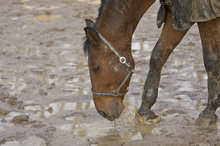Early spring is the worst season for mud. After an entire winter of wet weather, farm owners are now facing existing muddy paddocks and pastures plus the new challenges of spring.

A better way to deal with mud in horse areas
With warmer spring temperatures, conditions in muddy horse areas become perfect for breeding the flies that will plague horses in the summer and also increase fungal and bacterial activity leading to infection and skin conditions like greasy heel or mud fever.
March, April, and May can be as wet or wetter than the fall and winter months and, with the introduction of warmer temperatures, conditions in muddy horse areas are now perfect for breeding the flies that will plague horses and riders in the summer.
Warmer temperatures also increase fungal and bacterial activity which can lead to infection and skin conditions like scratches, AKA greasy heel or mud fever.
For the farms that are still covered in snow in February, the coming snow melt is about to make a mess out of the sensitive ground that still lacks lush grass to hold it in place.
Many horse owners donât want to wait for summer to enjoy a healthier and cleaner environment on their farm. These proactive individuals and professionals are installing a new product called LighthoofTM.
Lighthoof is a thin-walled, flexible plastic panel, which creates a supported layer of fine gravel, that immediately solves even the worst mud problems and prevents those problems from occurring in the future.
The 6â wide by 12â long panels work using a US Army Corps of Engineers technology that holds gravel in a series of 3â deep, hoof-sized, welded cells to create enhanced stability and prevent mixing or erosion.
Lighthoof panels can be installed in the wet spring directly over the existing muddy ground by placing a layer of geotextile fabric underneath the panels. There is no need to excavate the existing mud or build up layers compacted gravel before applying the panels to the area. It is perfect for paddocks, pathways, sacrifice areas, in front of gates, and in runs off of stalls.
See how Lighthoof works in a new video at: https://vimeo.com/116107077
Lighthoof can be ordered online at www.lighthoof.com or purchased at a participating farm and feed store for a DIY installation. Lighthoof can also be purchased with installation from a qualified contractor. A listing of stores and contractors can be found at www.lighthoof.com
